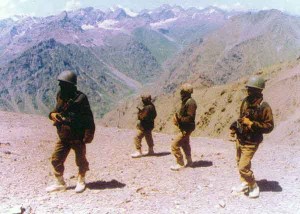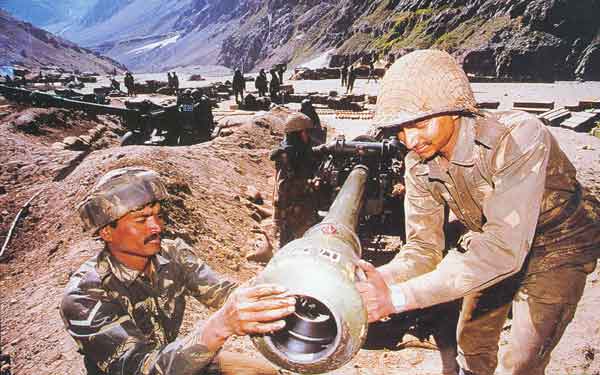Jointness among the services remains a chimera. The creation of the Integrated Defence Staff (IDS), but the non-implementation of the Chief of Defence Staff have left the three services where they were earlier on their own. For true jointness, planning and acquisition functions must be integrated. To this day, budget allocation is on time-tested percentage basis resulting in wasteful expenditure and lack of inter-operability. Future wars will be time-critical and real-time communications will be a decisive factor in the outcome of operations. That is why the USA has created a single-backbone C4ISR capability. What this means is that the US army, navy, air force and the marines use the same communications medium during peace and war.
In India, however, each service has opted for different communication systems with the facility of interface. No single back-bone C4ISR has yet been planned.
A single-backbone C4ISR can simultaneously process inputs from disparate sources like satellites, UAVs, AWACS, sigint and humint to present a cohesive and consolidated picture to decision makers without loss of time. In India, however, each service has opted for different communication systems with the facility of interface. No single back-bone C4ISR has yet been planned. The time penalty in such a system could prove fatal, given that we operate in a nuclear environment.
India’s acquisition process is a complex and complicated one. It gives a chance to all and sundry, including those whose bids have been rejected, to cry foul, at which point the entire cycle is gone through again with the resultant time delay in acquiring and operationalizing the concerned product. The Raksha Mantri, on being reappointed to the post after the general elections, said that he would not allow any corrupt practices in the weapon acquisition process and would ensure the guilty are punished. This is an unexceptionable statement, but it is strange that even after so many years, we have been unable to straighten out the system. The damage that delayed acquisitions cause to the national security has to be considered.
The Raksha Mantri said that he would not allow any corrupt practices in the weapon acquisition process and would ensure the guilty are punished…it is strange that even after so many years, we have been unable to straighten out the system.
While India wrestles with various military issues, including the bureaucracy initiated one on pay and perquisites after the 6th Central Pay Commission, our neighbors are spending money and time to improve their respective arsenals. Pakistan, with a fragile democracy which is firmly under army control, with a basket case economy that totters on the brink of collapse and with continuing internal strife which till recently threatened the safety of its nuclear arsenal, has managed to convince the world that it is in the forefront of fight against terror and therefore must be supported by all. And both China, the rising power, and the USA, the only superpower, are providing Pakistan with arms and sophisticated weapon systems. India’s claim that Pakistan is part of the problem is brushed aside and it is told to exercise restraint, even after hundreds of Indian citizens are killed by terrorists trained and nurtured in Pakistan. USA is pumping in billions of dollars into Pakistan to fight terror, but the funds are being misused by Pakistan to acquire weapons that can only be employed against India.
The perpetrators of the 26/11 terror attacks still roam free in Pakistan, but USA, supposedly India’s strategic partner, advises India to recommence the stalled dialogue with Pakistan and also thin troops on India’s western border to ‘reassure’ Pakistan. The latest action by the Pakistan Army is double-edged and the USA knows it but cannot do anything about it. The Pakistan Army is targeting the ‘bad’ Pakistani Taliban, as represented by Baitullah Mehsud who has carried out a series of terror attacks in Pakistan, including the one that killed Benazir Bhutto, but is keeping away from what Pakistan calls the ‘good’ Afghan Taliban, whose cooperation will be required in future to create ‘strategic space’ for Pakistan in an Afghanistan without US and Indian presence. Pakistan has pulled off a diplomatic coup of sorts and Indian diplomacy has failed, but that subject must be addressed elsewhere.
China has been an ‘all-weather’ friend of Pakistan and has time and again lived upto its reputation. During each India–Pakistan war, China has ‘leaned’ on India to try and dilute the forces arrayed against Pakistan. During the Kargil war, satellite images showed weapon shipments from China moving into Pakistan-occupied Kasmir along the Karkoram highway. More than 70 percent of Pakistan’s military hardware, including 1600 MBTs, 400 combat aircraft and 40 naval vessels have been supplied by China. Almost the entire Pakistani military–industrial infrastructure has been established by the Chinese. This includes ‘heavy rebuild factories’ and aircraft manufacturing facilities. Every missile project in Pakistan has been initiated through active Chinese or North Korean assistance. Chinese and North Korean connivance in Pakistan’s nuclear programme has been well documented by international watch agencies. China has trained Pakistani nuclear scientists, provided dual-use technology, built nuclear reactors and provided missile technology to Pakistan.
 The China–Pakistan nexus works differently for China. China considers Pakistan as part of its ‘containment through surrogates’ stratagem aimed at India. This stratagem is discernible in China wooing all countries around India. It has helped Sri Lanka, Nepal, Myanmar and Bangladesh economically and militarily. The construction of ports in Gwadar, Myanmar and Sri Lanka allows China to resupply its naval ships in the Indian Ocean. China is conscious that its energy requirements pass through the Indian Ocean and its naval build-up caters to protection of the sea lines of communication that carry this energy. China is actively shoring up its energy security. It has, invested in or partnered with, all oil and natural gas producing nations. Recently China and Iran signed a deal to develop the world’s largest natural gas field, in a deal valued at 4.8 billion USD. The South Paro fields, shared between Iran and Qatar, has an estimated gas reserves of 14 trillion cubic metres – enough to meet Europe’s gas needs for the next 25 years.
The China–Pakistan nexus works differently for China. China considers Pakistan as part of its ‘containment through surrogates’ stratagem aimed at India. This stratagem is discernible in China wooing all countries around India. It has helped Sri Lanka, Nepal, Myanmar and Bangladesh economically and militarily. The construction of ports in Gwadar, Myanmar and Sri Lanka allows China to resupply its naval ships in the Indian Ocean. China is conscious that its energy requirements pass through the Indian Ocean and its naval build-up caters to protection of the sea lines of communication that carry this energy. China is actively shoring up its energy security. It has, invested in or partnered with, all oil and natural gas producing nations. Recently China and Iran signed a deal to develop the world’s largest natural gas field, in a deal valued at 4.8 billion USD. The South Paro fields, shared between Iran and Qatar, has an estimated gas reserves of 14 trillion cubic metres – enough to meet Europe’s gas needs for the next 25 years.
India climbed to great heights during the Kargil war, but thereafter, disappointingly, the journey has been downhill.
Militarily, China has sprinted ahead of India. There was a time when the Indian Navy and IAF were considered superior to their Chinese counterparts, but times have changed – to India’s disadvantage. China has a focussed and time-bound military modernization plan, India’s modernization plan is unwieldy with each service going its own way. The lessons of Kargil on jointness are yet to be learnt. China’s military, the PLA, is pursuing a transformation strategy from a mass army designed for protracted wars of attrition to one capable of fighting short duration high-intensity, high-tech wars in an environment of ‘informatization’ (net-centric warfare). The pace of this transformation has accelerated in recent years with the acquisition of advanced foreign weapon systems (mainly Russian), high levels of investment in its indigenous defence, science and technology sectors and an overhaul of its somewhat archaic military doctrines. China’s ‘strategic reach’ has improved considerably as it focuses on Taiwan and the South-China Sea as potential conflict areas. If these two problems are resolved out, then the only other major territorial issue that China has is with India. China is also developing disruptive technologies for anti-access and area-denial, as well as for nuclear, space and cyber warfare. These will, in future, enable China to project power to ensure access to resources or to enforce claims to disputed territories.
India’s new goverment, with a strengthened mandate, will have to weigh its strategic options. The developing geo-political situation in South Asia holds many pitfalls for India and it will have to play its cards carefully. Some tentative steps like bolstering our troop strength in Arunachal Pradesh and improving the IAF’s strike capability in the eastern sector have attracted sharp remarks from Chinese media, obviously with official backing. India has to fortify its position in the so-called disputed areas to counter any Chinese moves. India has some advantages in the region, especially when it comes to air operations and this should be exploited to the fullest. China will probe our defences and resolve in the near future and the Indian military has to be prepared.
The Kargil war was a warning which we have ignored. The national introspection that followed, gave us the opportunity to overhaul our entire security apparatus, plug the many loopholes, improve internal security, tighten up border and coastal management and modernize our military. But political indifference, diplomatic inefficacy, bureaucratic apathy and military disinterest have brought the country to a situation where its options are being continuously reduced by other players in the international game of geo-politics. The newly elected government has to create strategic opportunities, through positive actions, for the country and steer the ship of the state through the choppy waters to a safer destination. India climbed to great heights during the Kargil war, but thereafter, disappointingly, the journey has been downhill.






Dawood Ibrahim and Shara Pawar are the culprits
Its a four year old article but still looks as of today`s except the referred new Govt has become now four year old. Sometimes I wonder its our general character which reflects in our policies and overall outlook of the Nation. Sir, I must say this is the period 14 years back when our brave officers and jawans had won unbelievable difficult war in Kargil. Some one rightly told in Kargil, a stone thrown from that height was as lethal as a bullet, while our Army faced volley of bullets fired from machine guns and some pica guns of Paki intruders as well other high calibre weapons. I still remember the picture of Shahid Capt. Vikram Batra holding one Pica gun! Yes the new generation doesn`t know about Capt. Batra or Manoj Pandey or those about 450 Shahid Jawans and officers. Its unfortunate that in country of ours there is no value of human life whether that is being lost in accidents, natural or man made calamities, innocent citizens being killed in terror attacks or death of a soldier defending his motherland. Death of air warriors in MIG Crashes, recent petition of right to live by some IAF officer in higher courts have expressed the anguish of the IAF.I am sorry to say but this country will not respect the martyrdom of a soldier till it learn to respect the value of life of its each citizen. It is depressing feeling.